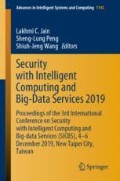Abstract
Audio information hiding (AIH) based on cochlear delay (CD) characteristics is a promising technique to deal with the trade-off between inaudibility and robustness requirements effectively. However, the use of phase-shift keying (PSK) for blindly detectable AIH based on CD characteristics caused abrupt phase changing (phase spread spectrum), which leads to bad inaudibility. This paper proposed the technique to reduce the spread spectrum from PSK by segment selection process with spline interpolation optimization. Objective evaluation to measure the detection accuracy (BDR) and inaudibility (PEAQ and LSD) was carried out with 102 various genre music clips dataset. Based on the evaluation result, our proposed method could successfully reduce the spread spectrum caused by PSK by having improvement on inaudibility test with adequate detection accuracy up to 1024 bps.
This work was supported by a Grant-in-Aid for Scientific Research (B) (No. 17H01761) and I-O DATA foundation.
Access this chapter
Tax calculation will be finalised at checkout
Purchases are for personal use only
References
Lin, Y., Abdulla, W.H.: Audio Watermark: A Comprehensive Foundation Using MATLAB. Springer, Heidelberg (2015)
Hartung, F., Kutter, M.: Multimedia watermarking techniques. Proc. IEEE 87(7), 1079–1107 (1999)
Hua, G., Huang, J., Shi, Y.Q., Goh, J., Thing, L.L.V.: Twenty years of digital audio watermarking – a comprehensive review. Signal Process. 218, 222–242 (2016)
Unoki, M., Hamada, D.: Method of digital-audio watermarking based on cochlear delay characteristics. Int. J. Innov. Comput. Inf. Control 6(3B), 1325–1346 (2010)
Unoki, M., Miyauchi, R.: Robust, blindly-detectable, and semi-reversible technique of audio watermarking based on cochlear delay. IEICE Trans. Inf. Syst. E98-D(1), 38–48 (2015)
Dau, T., Wegner, O., Mallert, V., Kollmeier, B.: Auditory brainstem response (ABR) with optimized chirp signals compensating basilar membrane dispersion. J. Acoust. Soc. Am. 107(3), 1530–1540 (2000)
Aiba, E., Tsuzaki, M., Tanaka, S., Unoki, M.: Judgment of perceptual synchrony between two pulses and verification of its relation to cochlear delay by an auditory model. Jpn. Psychol. Res. 50(4), 204–213 (2008)
Unoki, M., Miyauchi, R.: Method of digital-audio watermarking based on cochlear delay characteristics. In: Multimedia Information Hiding Technologies and Methodologies for Controlling Data, pp. 42–70. IGI Global (2013)
Rabiner, L.R., Schafer, R.W., Rader, C.M.: The chirp-z transform algorithm. IEEE Trans. Audio Electroacoustics AU-17(2), 86–92 (1969)
Rabiner, L.R., Schafer, R.W., Rader, C.M.: The chirp-z transform algorithm and its application. Bell Syst. Tech. J. 48 (1969). https://doi.org/10.1002/j.1538-7305.1969.tb04268.x
Martin, G.D.: Chirp Z-Transform Spectral Zoom Optimization with MATLAB, Sandia National Laboratories SAND 2005-7084 (2005)
Mawalim, C.O., Unoki, M.: Feasibility of audio information hiding using linear time variant IIR filter based on cochlear delay. In: NCSP 2019 Proceedings, pp. 323–326 (2019)
Goto, M., Hashiguchi, H., Nishimura, T., Oka, R.: RWC music database: music genre database and musical instrument sound database. In: Proceedings of ISMIR, pp. 229–230 (2003)
Kabal, P.: An examination and interpretation of ITU-R BS. 1387: perceptual evaluation of audio quality. Technical report, TSP Lab, McGill University (2003). http://mmsp.ece.mcgill.ca/Documents
Gray, A.J., Markel, J.: Distance measures for speech processing. In Proceedings of International Conference on Acoustics Speech and Signal Processing, vol. 24, no. 5, pp. 380–391 (1976)
Author information
Authors and Affiliations
Corresponding author
Editor information
Editors and Affiliations
Rights and permissions
Copyright information
© 2020 Springer Nature Switzerland AG
About this paper
Cite this paper
Mawalim, C.O., Unoki, M. (2020). Audio Information Hiding Based on Cochlear Delay Characteristics with Optimized Segment Selection. In: Jain, L., Peng, SL., Wang, SJ. (eds) Security with Intelligent Computing and Big-Data Services 2019. SICBS 2019. Advances in Intelligent Systems and Computing, vol 1145. Springer, Cham. https://doi.org/10.1007/978-3-030-46828-6_12
Download citation
DOI: https://doi.org/10.1007/978-3-030-46828-6_12
Published:
Publisher Name: Springer, Cham
Print ISBN: 978-3-030-46827-9
Online ISBN: 978-3-030-46828-6
eBook Packages: Intelligent Technologies and RoboticsIntelligent Technologies and Robotics (R0)

